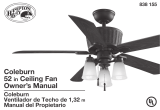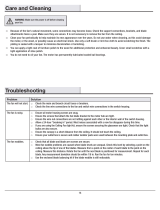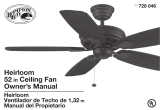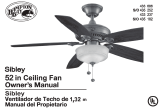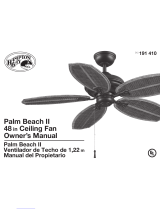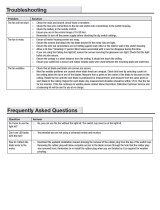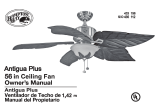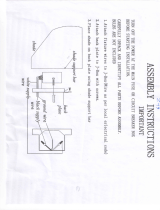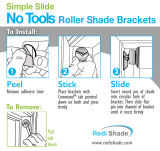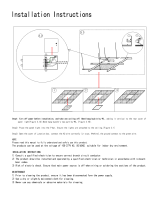Page is loading ...

Courtney
42 in Ceiling Fan
Owner’s Manual
Courtney
Ventilador de Techo de 1,07
m
Manual del Propietario
504 149
150 mm
213 mm
The spot color is for reference proof only, please follow
pantone guide for actual color when printing.
This line is for die-cut position only
DO NOT PRINT IT!!!
Black Magenta Yellow Black PMS 465C PMS 5425C PMS 632C Die
Total Colors
1C
Coating
Varnish
ADDITIONAL INFORMATION
V0.0
10-01-18
V0.0
17 Apr 09
V0.0
17 Apr 09
V0.0
17 Apr 09
V0.0
17 Apr 09
V0.0
17 Apr 09
V0.0
17 Apr 09
V0.0
17 Apr 09
V0.0
17 Apr 09
V0.0
17 Apr 09
V0.0
17 Apr 09
V0.0
17 Apr 09
V0.0
17 Apr 09
V0.0
17 Apr 09
V0.0
17 Apr 09
1. UPC at 100% and without truncated.
2. The smallest fonts size is 6 points in the artwork.
File Name:
Artwork Version:
Customer:
Buyer:
Sold In Country:
Item Number:
Catergory:
MVendor:
Printing Type:
Translation Agency:
Size:
Blank Size:
Artist:
C.S.:
Date:
HD_014839A_504149_MC
V0.0
Home Depot
N/A
US
TBA
Hampton Bay (Ceiling Fan)
KOF CLZ
Offest
TBA
213(L) x 150(W) mm
213(L) x 150(W) mm
Mary
Chris Que
10-01-18

42” Courtney
Ceiling Fan by Hampton Bay
Accu-arm™ for Accurate
and Easy Installation
3-Speed Reverse Function for
Year-Round Comfort and Savings
Steeper Blade Pitch for
Greater Air Movement
Tri-Mount Installation
QUESTIONS, PROBLEMS, MISSING PARTS:
Before returning to your local Home Depot, please call our
Customer Service Team at 1-877-527-0313 or visit www.homedepot.com.
Please reference your SKU (504 149 oil-rubbed bronze)
or UPC (82392 618766R oil-rubbed bronze).
Thank you for purchasing this Hampton Bay ceiling
fan. This product has been manufactured with the
highest standards of safety and quality. The nish
of this fan is weather resistant, but over time will
naturally weather and fade.
Safety Rules .................................. 1
Unpacking Your Fan .................... 2
Installing Your Fan ...................... 3
Operating Your Fan ..................... 11
Care of Your Fan .......................... 12
Troubleshooting ............................ 12
Specications ................................ 13
Warranty Information ................. 14
Table of Contents

Safety Rules .................................. 1
Unpacking Your Fan .................... 2
Installing Your Fan ...................... 3
Operating Your Fan ..................... 11
Care of Your Fan .......................... 12
Troubleshooting ............................ 12
Specications ................................ 13
Warranty Information ................. 14
To reduce the risk of electric shock, insure electricity 1.
has been turned off at the circuit breaker or fuse box
before beginning.
All wiring must be in accordance with the National 2.
Electrical Code ANSI/NFPA 70-1999 and local electrical
codes. Electrical installation should be performed by a
qualied licensed electrician.
WARNING:3. To reduce the risk of re or electric shock, do
not use this fan with any solid-state speed control device.
CAUTION:4. To reduce the risk of personal injury, use only
the screws provided with the outlet box.
The outlet box and support structure must be securely 5.
mounted and capable of reliably supporting a minimum of
35 pounds. Use only UL Listed outlet boxes marked “FOR
FAN SUPPORT.”
The fan must be mounted with a 6. minimum of 7 feet
clearance from the trailing edge of the blades to the oor.
Do not operate reversing switch while fan blades are in 7.
motion. Fan must be turned off and blades stopped before
reversing blade direction.
Avoid placing objects in path of the blades.
8.
To avoid personal injury or damage to the fan and 9.
other items, be cautious when working around or
cleaning the fan.
Do not use water or detergents when cleaning the fan or fan 10.
blades. A dry dust cloth or lightly dampened cloth will be
suitable for most cleaning.
After making electrical connections, spliced conductors 11.
should be turned upward and pushed carefully up into
outlet box. The wires should be spread apart with the
grounded conductor and the equipment-grounding
conductor on one side of the outlet box.
Electrical diagrams are for reference only.12.
All set screws must be checked and retightened where 13.
necessary before installation.
Safety Rules 1.
READ AND SAVE THESE INSTRUCTIONS
TO REDUCE THE RISK OF FIRE, ELECTRIC SHOCK OR PERSONAL
INJURY, MOUNT FAN TO OUTLET BOX MARKED ACCEPTABLE FOR
FAN SUPPORT WITH THE SCREWS PROVIDED WITH THE OUTLET
BOX. MOST OUTLET BOXES COMMONLY USED FOR THE SUPPORT
OF LIGHTING FIXTURES ARE NOT ACCEPTABLE FOR FAN SUPPORT
AND MAY NEED TO BE REPLACED. CONSULT A QUALIFIED ELECTRI-
CIAN IF IN DOUBT.
TO REDUCE THE RISK OF PERSONAL INJURY, DO NOT BEND THE
BLADE BRACKETS (ALSO REFERRED TO AS “FLANGES”) DURING
ASSEMBLY OR AFTER INSTALLATION. DO NOT INSERT OBJECTS IN
THE PATH OF THE BLADES.
PLEASE REMOVE RUBBER MOTOR STOPS ON THE BOTTOM OF THE
FAN BEFORE INSTALLING BLADES OR TESTING MOTOR.

Blade Attachment Hardwarea.
(12 washer head screws)
Mounting Hardware b.
(1 hanger pin, 1 locking pin, 3 plastic
wire connectors, 1 rubber gasket)
Electrical Hardware & Balancing Kit c.
(1 pull chain for the fan, 1 pull chain for
the light kit, blade balancing kit)
Extra Blade Bracket Attachment d.
Hardware
(1 screw and lockwashers)
Glass Shade7.
Blades (4)8.
Bulb9.
Blade Bracket (ange) Set (4) 10.
with blade bracket screws
pre-installed
Slide-On Mounting Plate (inside Canopy)1.
Downrod and Hanger Ball Assembly2.
Canopy with Canopy Ring Attached3.
Decorative Motor Collar Cover 4.
Fan Motor Assembly5.
Light Kit Assembly6.
2. Unpacking Your Fan
IMPORTANT: THIS PRODUCT AND/OR COMPONENTS ARE COVERED BY
ONE OR MORE OF THE FOLLOWING U.S. PATENTS: 5,947,436; 5,988,580;
5,971,573; 6,010,110; 6,010,306; 6,039,541; 6,046,416 AND OTHER
PATENTS PENDING.
Unpack your fan and check the contents. You should have the following items:

Installing Your Fan 3.
Tools Required
Phillips screw driver, straight slot screw
driver, adjustable wrench, step ladder, and
wire cutters.
Mounting Options
If there isn’t an existing mounting box, then
read the following instructions. Disconnect
the power by removing fuses or turning off
circuit breakers.
Secure the outlet box directly to the building
structure. Use appropriate fasteners and
building materials. The outlet box and its
support must be able to fully support the
moving weight of the fan (at least 35 lbs.)
Do not use plastic outlet boxes.
Figures 1, 2, and 3 are examples of different
ways to mount the outlet box.
Outlet Box
Note: You may need a longer downrod to
maintain proper blade clearance when install-
ing on a steep, sloped ceiling. The maximum
angle allowable is 30˚. If the canopy touches
downrod, remove the decorative canopy
bottom cover and turn the canopy 180˚ before
attaching the canopy to the mounting plate.
Outlet Box
To hang your fan where there is an existing
xture but no ceiling joist, you may need an
installation hanger bar as shown in Figure 4
(available at your Hampton Bay retailer).
TO REDUCE THE RISK OF FIRE, ELECTRIC
SHOCK OR PERSONAL INJURY, MOUNT
FAN ONLY TO AN OUTLET BOX MARKED
ACCEPTABLE FOR FAN SUPPORT AND
USE THE MOUNTING SCREWS PROVIDED
WITH THE OUTLET BOX. OUTLET BOXES
COMMONLY USED FOR THE SUPPORT OF
LIGHTING FIXTURES MAY NOT BE ACCEPT-
ABLE FOR FAN SUPPORT AND MAY NEED TO
BE REPLACED. CONSULT A QUALIFIED ELEC-
TRICIAN IF IN DOUBT.
Figure 1
Figure 2
Figure 4
Figure 3

Remove the mounting plate from the 2.
canopy by loosening the four screws on
the top of the canopy. Remove the two
non-slotted screws and loosen the slotted
screws. This will enable you to remove the
mounting plate (Figure 6).
4.
Hanging the Fan
REMEMBER to turn off the pow-
er. Follow the steps below to hang your
fan properly.
NOTE: This ceiling fan is supplied with two
types of hanging assemblies; the standard
ceiling installation using the downrod with
ball and socket mounting, and the “close-to-
ceiling” mounting. The “close-to-ceiling”
mounting is recommended in rooms with
less than 8-foot ceilings or in areas where
additional space is desired from the oor
to the fan blades. When using standard
downrod installation, the distance from the
ceiling to the bottom of the fan blades will be
approximately 11 inches. The “close-to-ceiling”
installation reduces the distance from the
ceiling to the bottom of the fan blades to
approximately 7 inches.
Once you have decided which ceiling
installation you will use, proceed with the
following instructions. Where necessary,
each section of the instructions will note the
different procedures to follow for the two
types of installation.
Standard Ceiling Mounting
Remove the canopy ring from the canopy 1.
by turning the ring to the right until it
unlocks (Figure 5).
Figure 5
Figure 6
Figure 7
Route the wires exiting the top of the 3.
fan motor through the decorative motor
collar cover then the canopy ring. Make sure
the slot openings are on top. Route the wires
through the canopy and then through the
ball/downrod assembly (Figure 7).
Loosen, but do not remove, the set 4.
screws on the collar on the top of the
motor housing.
Align the holes at the bottom of the 5.
downrod with the holes in the collar
on top of the motor housing (Figure 7).
Carefully insert the bolt through the
holes in the collar and downrod. Be
careful not to jam the bolt against the
wiring inside the downrod. Insert the
Clevis pin through the hole near the
Pin in
Locked
Position
Locking Pin
Hanger Pin
Motor Collar
Cover
Canopy Ring
Canopy
Downrod/Ball
Assembly
Motor Wires
Hook
Ceiling
Mounting
Plate
Mounting
Screws
(Supplied With
Outlet Box)
UL Listed
Outlet Box
Slide Mounting
Plate Over
Screw Heads
120V Wires

end of the bolt until it snaps into its
locked position, as noted in the circle inset
of Figure 7.
Re-tighten the set screws on the collar on top 6.
of the motor housing (Figure 8).
Make sure the grommet is properly installed 7.
in the collar cover, then slide the collar cover
on the downrod until it rests on the motor
housing. Be sure that the canopy and the col-
lar cover are both oriented correctly.
Proceed to “Installing the Fan” section.8.
5.
Figure 9
Figure 10
Figure 11
FAILURE TO PROPERLY INSTALL CLEVIS PIN
AS NOTED IN STEP 6 COULD RESULT IN FAN
LOOSENING AND POSSIBLY FALLING.
FAILURE TO COMPLETELY TIGHTEN THE
THREE SCREWS IN STEP 7 COULD RESULT IN
FAN LOOSENING AND POSSIBLY FALLING.
Figure 8
“Close-to-Ceiling” Mounting
Remove canopy ring from the canopy by 1.
turning the ring to the right until it unlocks
(Figure 5).
Remove the mounting plate from the canopy 2.
by loosening the four screws on the top of the
canopy. Remove the two non-slotted screws
and loosen the slotted screws. This will enable
you to remove the mounting plate (Figure 6).
Remove the decorative canopy bottom cov-3.
er from the canopy by depressing the three
studs (Figure 9).
Remove three of the six screws and lock 4.
washers (every other one) securing the mo-
tor collar to the top of the fan motor housing
(Figure 10).
Place the rubber gasket over the 5.
remaining three screws, route the wires
exiting the top of the fan motor through the
canopy ring (make sure the slot openings
are on top), then proceed to place the ceiling
canopy over the collar at the top of the motor
(Figure 11).
Align the mounting holes with the holes 6.
in the motor and fasten, using the three
screws and lock-washers removed in
step 4 (Figure 11).
Tighten the mounting screws securely.7.

Installing Fan to
the Outlet Box
Pass the 120-volt supply wires through the 1.
center hole in the ceiling mounting plate as
shown in Figure 7.
Install the ceiling mounting plate on the 2.
outlet box, by sliding the mounting plate
over the two screws provided with the outlet
box (Figure 7). When using close-to-ceiling
mounting, it is important that the mount-
ing plate be level. If necessary, use leveling
washers (not included) between the mount-
ing plate and the outlet box. Note that the
at side of the mounting plate is toward the
outlet box (Figure 7).
Securely tighten the two mounting screws.3.
Carefully lift the assembly up to the ceil-4.
ing mounting plate. If using close-to-ceil-
ing mounting, hang the fan on the hook
provided by utilizing one of the holes at
the outer rim of the ceiling canopy (Fig-
ure 12). If using standard mounting, seat
the hanger ball in the mounting plate
socket. Make sure the tab on the mount-
ing plate socket is properly seated in
the groove in the hanger ball.
Figure 12
WHEN MOUNTING THE FAN ON A SLOPED
CEILING, THE STANDARD BALL/DOWNROD
MOUNTING METHOD MUST BE USED. THE
MOUNTING PLATE MUST BE MOUNTED SO
THAT THE SLOT OPENINGS ARE ON THE
LOWER SIDE BY SLIDING THE MOUNTING
PLATE FROM THE TOP DOWN.
THE HOOK AS SHOWN IN FIGURE 12 IS ONLY
TO BALANCE FAN WHILE ATTACHING WIRING.
FAILURE TO HANG AS SHOWN IN FIGURE 12
MAY RESULT IN HOOK BREAKING, CAUSING
THE FAN TO FALL. HOOK MUST PASS FROM
INSIDE TO OUTSIDE OF CANOPY
WHEN USING THE STANDARD BALL/DOWNROD
MOUNTING, THE TAB IN THE RING AT THE BOT-
TOM OF THE MOUNTING PLATE MUST REST
IN THE GROOVE OF THE HANGER BALL FAIL-
URE TO PROPERLY SEAT TAB IN THE GROOVE
COULD CAUSE DAMAGE TO THE WIRING.
6.

7.
Making the Electrical
Connections
REMEMBER to disconnect the power. If
you feel you do not have enough electrical
wiring knowledge or experience, have your fan
installed by a licensed electrician.
Follow the steps below to connect the fan
to your household wiring. Use the wire
connecting nuts supplied with your fan. Se-
cure the connectors with electrical tape.
Make sure there are no loose strands or
connections.
Step 1 Connect the two green fan ground wires,
located on the downrod and mounting plate, to
the household ground wire. When using Close-
to-Ceiling mounting, there is only one green
ground wire from the ceiling mounting plate
since the ball/downrod assembly is not used.
Step 2 Connect the fan light supply (blue) wire
and the fan supply (black) wire to the black
household supply wire as shown in gure 13.
Step 3 Connect the neutral fan (white) wire to
the white neutral household wire.
Step 4 After connecting the wires, spread them
apart so that the green and white wires are on
one side of the outlet box and the black wire is
on the other side.
Step 5 Turn the wire connecting nuts upward
and push the wiring into the outlet box.
EACH WIRE NUT (WIRE CONNECTOR) SUP-
PLIED WITH THIS FAN IS DESIGNED TO ACCEPT
UP TO ONE 12 GAUGE HOUSE WIRE AND TWO
WIRES FROM THE FAN. IF YOU HAVE LARGER
THAN 12 GAUGE HOUSE WIRING OR MORE
THAN ONE HOUSE WIRE TO CONNECT TO THE
FAN WIRING, CONSULT AN ELECTRICIAN FOR
THE PROPER SIZE WIRE NUTS TO USE.
TO REDUCE RISK OF FIRE OR ELECTRIC
SHOCK, DO NOT USE A WALL MOUNTED SOLID
STATE SPEED CONTROL WITH THIS FAN. IT
WILL PERMANENTLY DAMAGE THE ELECTRON-
IC CIRCUITRY.
Figure 13

8.
Finishing the Fan
Installation
STANDARD CEILING MOUNTING
Align the locking slots of the ceiling canopy 1.
with the two screws in the mounting plate.
Push up to engage the slots and turn clock-
wise to lock in place. Immediately tighten
the two mounting screws rmly.
Install the remaining two mounting 2.
screws into the holes in the canopy and
tighten rmly.
Install the decorative canopy ring by 3.
aligning the ring’s slots with the screws
in the canopy. Rotate the ring counter-
clockwise to lock in place.
You may now proceed to attaching the 4.
fan blades.
Attaching the
Fan Blades
NOTE: Your fan blades are reversible. Select
the blade side nish which best accentuates
your decor.
Attach the blade to blade bracket using the 1.
screws as shown in gure 14. Please note
that the rubber washers are pre-attached
to the blade bracket. Start a screw into
the bracket. Repeat for the two remaining
screws.
Tighten each screw securely. 2.
CLOSE-TO-CEILING MOUNTING
Carefully unhook the fan from the mount-1.
ing plate and align the locking slots of the
ceiling canopy with the two screws in the
mounting plate. Push up to engage the slots
and turn clockwise to lock in place. Imme-
diately tighten the two mounting screws
rmly.
Install the remaining two mounting screws 2.
into the holes in the canopy and tighten
rmly.
Install the decorative canopy ring by align-3.
ing the ring’s slots with the screws in the
canopy. Rotate the ring clockwise to lock in
place.
You may now proceed to attaching the fan 4.
blades.
WHEN USING THE STANDARD BALL/DOWNROD
MOUNTING, THE TAB IN THE RING AT THE BOT-
TOM OF THE MOUNTING PLATE MUST REST IN
THE GROOVE OF THE HANGER BALL. FAILURE
TO PROPERLY SEAT THE TAB IN THE GROOVE
COULD CAUSE DAMAGE TO WIRING.
LOCKING SLOTS OF CEILING CANOPY ARE
PROVIDED ONLY AS AN AID TO MOUNTING.
DO NOT LEAVE FAN ASSEMBLY UNATTENDED
UNTIL ALL FOUR CANOPY SCREWS ARE EN-
GAGED AND FIRMLY TIGHTENED.
Figure 14
Fasten the blade assembly to the motor by 3.
inserting the alignment post into the slot on
the bottom of the motor and tightening the
blade bracket screws. Please note that the
blade bracket screws are pre-installed into
the blade bracket (Figure 15).

Figure 15
9.
ing the three screw holes and securing with
three mounting screws and lockwashers that
were removed in step 1.
Route the pull chains from the switch 4.
cup through the holes on the sup-
port bar of the light kit assembly.
NOTE: Route the chains through the holes
of the support bar from inside to outside to
avoid the chains touching the glass and for
easy pulling.
With power off, install the one uorescent 5.
bulb (Max. 14W, Supplied) by screwing into
the light bulb socket.
Place the glass shade into the light kit t-6.
ter, aligning the three at areas on the top
ange of the glass shade with the three
raised dimples in the light kit tter. Then
turn the glass shade clockwise until it stops.
NOTE: PERIODICALLY CHECK THAT
THE GLASS SHADE IS SEATED FUL-
LY CLOCKWISE IN THE LIGHT KIT
FITTER.
Attach the pull chain fobs provided to the 7.
pull chains exiting the holes of the support
bar.
Installing the Light Kit
/Glass Shades
CAUTION - To reduce the risk of electrical
shock, disconnect the electrical supply circuit
to the fan before installing light kit.
Remove the three mounting screws and 1.
lockwashers on the switch cup of the fan
motor assembly (gure 16).
Connect the wires from the light kit as-2.
sembly to the wires from the switch cup of
the fan motor assembly by connecting the
molded adaptor plugs together.
Mount the light kit assembly to the switch 3.
cup of the fan motor assembly by align-
Figure 16
Repeat steps 1, 2 & 3 for the remaining 4.
blades.
Alignment
Post
Blade
Screws
Slot

10.
Blade Balancing
All blades are grouped by weight. Because nat-
ural woods vary in density, the fan may wobble
even though the blades are weight matched.
The following procedure should correct most
fan wobble. Check after each step.
Check that all blade screws are secure.1.
Most fan wobble problems are caused when 2.
blade levels are unequal. Check this level by
selecting a point on the ceiling above the tip
of one of the blades. Measure from a point
on the center of each blade to the point on
the ceiling. Measure this distance as shown
in Figure 17. Rotate the fan until the next
blade is positioned for measurement. Repeat
for each blade. Measurement deviations
should be within 1/8”. Run the fan for 10
minutes.
Use the enclosed Bladed Balancing Kit if 3.
the blade wobble is still noticeable.
TO REDUCE THE RISK OF PERSONAL INJURY,
DO NOT BEND THE BLADE HOLDERS WHILE
INSTALLING, BALANCING THE BLADES, OR
CLEANING THE FAN. DO NOT INSERT FOREIGN
OBJECTS BETWEEN ROTATING BLADES.
Figure 17

Operating Your Fan 11.
Turn on the power and check the operation
of the fan. The pull chain controls the fan
speed as follows: 1 pull - High, 2 pulls -
Medium, 3 pulls - Low and 4 pulls - Off.
The other pull chain controls the light On
and Off.
Speed settings for warm or cool weather
depend on factors such as room size, ceil-
ing height, number of fans, and so on.
The slide switch controls the direction
forward (switch down) or reverse (switch
up).
Figure 18
Figure 19
WAIT FOR THE FAN TO STOP BEFORE REVERS-
ING THE DIRECTION OF BLADE ROTATION.
Warm weather - (Forward) A downward
air ow creates a cooling effect as shown
in Figure 18. This allows you to set your
air conditioner on a higher setting without
affecting your comfort.
Cool weather - (Reverse) An upward air
ow moves warm air off the ceiling are as
shown in Figure 19. This allows you to set
your heating unit on a lower setting with-
out affecting your comfort.

12. Care of Your Fan And Troubleshooting
Care of Your Fan
Here are some suggestions to help you
maintain your fan.
Because of the fan’s natural movement, 1.
some connections may become loose.
Check the support connections, brackets,
and blade attachments twice a year. Make
sure they are secure. (It is not necessary to
remove fan from ceiling.)
Clean your fan periodically to help maintain 2.
its new appearance over the years. Do not
use water when cleaning, this could damage
the motor, or the wood or possibly cause
an electrical shock. Use only a soft brush
or lint-free cloth to avoid scratching the
nish. The plating is sealed with a lacquer
to minimize discoloration or tarnishing.
Warning - Make sure the power is off
before cleaning your fan.
You can apply a light coat of furniture pol-3.
ish to the wood for additional protection
and enhanced beauty. Cover small scratches
with a light application of shoe polish.
There is no need to oil your fan.4.
The motor has permanently lubricated
sealed ball bearings.
MAKE SURE THE POWER IS OFF AT THE ELECTRICAL PANEL BOX BE-
FORE YOU ATTEMPT TO MAKE ANY REPAIRS. REFER TO THE SECTION,
“MAKING ELECTRICAL CONNECTIONS.”
Fan will not start
Fan sounds noisy
Troubleshooting
Problem Solution
Check main and branch circuit fuses or breakers1.
Check line wire connections to the fan and switch wire connections in 2.
the switch housing. CAUTION: Make sure main power is off.
Make sure all motor housing screws are snug.1.
Make sure the screws that attach the fan blade bracket to the motor hub 2.
are tight.
Make sure wire nut connections are not rattling against each other or 3.
the interior wall of the switch housing.
CAUTION: Make sure power is off.
Allow a 24-hour “breaking in” period. Most noises associated with a 4.
new fan disappear during this time.
If using the Ceiling Fan light kit, make sure the screws securing the 5.
glassware are tight. Check that the light bulb is also secure.
Make sure the canopy is a short distance from the ceiling. 6.
It should not touch the ceiling.
Make sure your outlet box is secure and rubber isolator pads were used 7.
between the mounting bracket and outlet box.
Make sure pull chains are not vibrating against glass or housing.8.

Specications 13.
FAN SIZE SPEED VOLTS AMPS WATTS RPM CFM N.W. G.W. C.F.
42”
Low 120 0.20 10 100 1580
13.2
Lbs
15.8
Lbs
1.33Med 120 0.29 22 160 2467
High 120 0.40 48 225 2996
These are approximate measures. They do not include Amps and Wattage used by the light kit.
Distributed by Home Depot U.S.A., Inc.
2455 Paces Ferry Rd. N.W. Atlanta, Georgia 30339
Vendor Number: 11688

Hampton Bay Lifetime Limited Warranty
Lifetime Warranty on Motor
Hampton Bay warrants the fan motor to be free from defects in workmanship and material present at
time of shipment from the factory for a lifetime after the date of purchase by the original purchaser.
Hampton Bay also warrants that all other fan parts, excluding any glass or acrylic blades, to be free
from defects in workmanship and material at the time of shipment from the factory for a period of
one year after the date of purchase by the original purchaser. We agree to correct such defects with-
out charge or at our option replace with a comparable or superior model if the product is returned
to Hampton Bay. To obtain warranty service, you must present a copy of the receipt as proof of
purchase. All costs of removing and reinstalling the product are your responsibility. Damage to any
part such as by accident or misuse or improper installation or by afxing any accessories, is not
covered by this warranty. Because of varying climatic conditions, this warranty does not cover any
changes in plated nishes, including rusting, pitting, corroding, tarnishing or peeling. Brass nishes
of this type give their longest useful life when protected from varying weather conditions. A certain
amount of “wobble” is normal and should not be considered a defect. Servicing performed by un-
authorized persons shall render the warranty invalid. There is no other express warranty. Hampton
Bay hereby disclaims any and all warranties, including but not limited to, those of merchantability
and tness for a particular purpose to the extent permitted by law. The duration of any implied war-
ranty which cannot be disclaimed is limited to the time period as specied in the express warranty.
Some states do not allow limitation on how long an implied warranty lasts, so the above limitation
may not apply to you. Hampton Bay shall not be liable for incidental, consequential, or special
damages arising out of or in connection with product use or performance except as may otherwise
be accorded by law. Some states do not allow the exclusion of incidental or consequential damages,
so the above exclusion or limitation may not apply to you. This warranty gives specic legal rights,
and you may also have other rights which vary form state to state. This warranty supersedes all prior
warranties. Shipping costs for any return of product as part of a claim on the warranty must be paid
by the customer.
IMPORTANT NOTE:
To ensure warranty service, if ever
necessary, please register your fan at:
gpwarranty.com
You must present a copy of the original
purchase receipt to obtain warranty service.
G.P. WARRANTY SERVICE CENTER, INC.
WARRANTY SECTION
1951 N.W. 22nd STREET
FORT LAUDERDALE, FLORIDA 33311
Attach receipt here for
easy location.
14. Warranty Information
/
